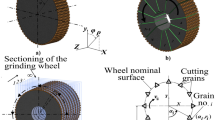Abstract
Grinding processes are often used for final finishing of components because of their ability to satisfy stringent requirements of surface roughness and dimensional tolerance. Surface topography generated during grinding depends upon many parameters like wheel parameters, wheel velocity, downfeed, grit density etc. and it also depends upon the type of grinding procedures (viz. plunge grinding, traverse grinding, helical grinding, touch dressing etc.) employed. Therefore, a correct examination of the parameters and type of process employed to carry out grinding are necessary. This paper is an attempt to develop the relation between the different grinding parameters and the grinding procedures like plunge, traverse and helical superabrasive grinding with touch dressing and the average surface roughness. For this purpose, a numerical simulation technique has been implemented to generate the grinding wheel topography. The ground workpiece surface has also been generated by simulating removal of work material depending upon the trajectory of the abrasive grits on the grinding wheel without taking rubbing and ploughing into consideration.







Similar content being viewed by others
Abbreviations
- α :
-
Semi apex angle of the square pyramidal grit
- θ :
-
Rotational angle of any grit
- a :
-
Infeed or downfeed
- b :
-
Base dimension of the grit
- c :
-
Grit density per unit area
- d g :
-
Average grit diameter
- d s :
-
Diameter of the grinding wheels
- h :
-
Height of the grit
- h a :
-
Average grit depth of cut
- x, z :
-
Coordinate of the grit tip
- v g :
-
Grinding speed
- v w :
-
Table speed in surface grinding
- R a :
-
CLA surface roughness
References
Chakrabarti S, Paul S (2008) Numerical modelling of surface topography in superabrasive grinding. Int J Adv Manuf Technol 39(1–2):29–38
Pandit SM, Wu SM (1973) Characterization of abrasive tools by continuous time series. ASME J Eng Ind 95B:821–826
Wang Y, Moon KS (1997) A methodology for the multi-resolution simulation of grinding wheel surface. Wear 211(2):218–225
Salisbury EJ, Domala KV, Moon KS, Miller MH, Sutherland JW (2001) A three-dimensional model for the surface texture in surface grinding, part 2: grinding wheel surface texture model. J Manuf Sci Eng 123(4):582–590
Salisbury EJ, Domala KV, Moon KS, Miller MH, Sutherland JW (2001) A three-dimensional model for the surface texture in surface grinding, part 1: surface generation model. J Manuf Sci Eng 123(4):576–581
Zhou X, Xi F (2002) Modelling and predicting surface roughness of the grinding process. Int J Mach Tools Manuf 42(8):967–977
Cooper W, Lavine AS (2000) Grinding process size effect and kinematics numerical analysis. J Manuf Sci Eng 122(1):59–69
Warnecke G, Zitt U (1998) Kinematic simulation for analyzing and predicting high-performance grinding processes. Ann CIRP 47(1):265–270
Koshy P, Jain VK, Lal GK (1997) Stochastic simulation approach to modelling diamond wheel topography. Int J Mach Tools Manuf 37(6):751–761
Chen X, Rowe WB (1996) Analysis and simulation of the grinding process. Part i: generation of the grinding wheel surface. Int J Mach Tools Manuf 36(8):871–882
Chen X, Rowe WB (1996) Analysis and simulation of the grinding process. Part ii: mechanics of grinding. Int J Mach Tools Manuf 36(8):883–896
Gong YD, Wang B, Wang WS (2002) The simulation of grinding wheels and ground surface roughness based on virtual reality technology. J Mater Process Technol 129(1–3):123–126
Malkin S (1989) Grinding technology: theory and applications of machining with abrasives. Horwood, Chichester
Ghosh A, Chattopadhyay AK (2007) Experimental investigation on performance of touch-dressed single-layer brazed cBN wheels. Int J Mach Tools Manuf 47:1206–1213
Ghosh A, Chattopadhyay AK (2007) On cumulative depth of touch-dressing of single layer brazed cBN wheels with regular grit distribution pattern. Mach Sci Technol 11(2):259–270
Vickerstaff TJ (1973) Wheel wear and surface roughness in cross feed surface grinding. Int J Mach Tool Des Res 13:183–198
Iwai M, Shiraishi Y, Ninomiya S, Uematsu T, Suzuki K (2009) Prediction of surface roughness by 3D-CAD model in helical scan grinding and groove grinding. Adv Mat Res 76–78:101–106
Zhang B, Uematsu T (1999) Surface generation mechanism in helical scan grinding: an analytical study. J Mater Process Technol 91(1):206–213
Jung-Sik H, Yang K, Soung-Sam C (2004) Grinding characteristics of conventional and ELID methods difficult-to-cut and hardened brittle materials. J Mater Process Technol 155–156:1196–1200
Author information
Authors and Affiliations
Corresponding author
Rights and permissions
About this article
Cite this article
Kumar, S., Paul, S. Numerical modelling of ground surface topography: effect of traverse and helical superabrasive grinding with touch dressing. Prod. Eng. Res. Devel. 6, 199–204 (2012). https://doi.org/10.1007/s11740-012-0370-1
Received:
Accepted:
Published:
Issue Date:
DOI: https://doi.org/10.1007/s11740-012-0370-1



